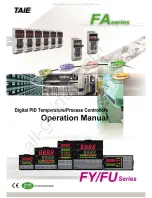
Getting Started with EZ-
PD™ CCG3PA
www.cypress.com
Document No. 002-18179 Rev. **
16
Figure 12. EZ-PD Analyzer Utility Showing PD Packets Captured on CC Line
Whenever a Type-C device is connected to the Type-C port of the CY4532 CCG3PA EVK, a PD contract is
established between the CCG3PA device and the attached Type-C device. The flow of CC messages as well as
source and sink Power Data Objects (PDOs
—used to expose source/sink port‘s power capabilities) between the
power port partners can be monitored on the PC by using the EZ-PD Protocol Analyzer and running the EZ-PD
Analyzer Utility. This information helps in debugging CCG3PA firmware if there are any issues (errors, delays, no
contract, and so on) related to establishing the power contract between the CCG3PA device and the attached Type-C
device.
5
CCG3PA Configuration Parameter Modification Example
Many CCG configuration parameters are stored in the configuration tables in the
device‘s internal flash memory. You
may need to make changes to these parameters based on system requirements and the end application. This section
provides a simple example of a Type-C ecosystem to describe how to change the configuration parameters using the
EZ-PD Configuration Utility
and how to verify the changes using the
CY4500 EZ-PD
TM
Protocol Analyzer
.
Consider the example of a Type-C device connected to the CY4532 CCG3PA EVK. Assuming that this Type-C
device supports a custom PDO, the power contract between it and the CCG3PA device of the EVK will be
successfully established utilizing the PDO only if the CCG3PA device supports the same custom PDO. The EZ-PD
Configuration Utility allows you to modify parameters such as the sink or source PDOs without making any changes
to the base firmware so that the CY4532 CCG3PA EVK can successfully establish a power contract with the device.
From a top-level perspective, the following are the steps to modify the CCG3PA
device‘s configuration parameters.
The following sections explain each step in detail.
1. Test the CY4532 CCG3PA EVK in the default configuration with a Type-C device to identify the established
power contract.
2. Update the configuration parameters (add a sink PDO supported by the device such as 14.8 V, 2 A) by using the
EZ-PD Configuration Utility.
3. Transmit the updated configuration parameters into the CCG3PA device by using the EZ-PD Configuration Utility
and verify.










































